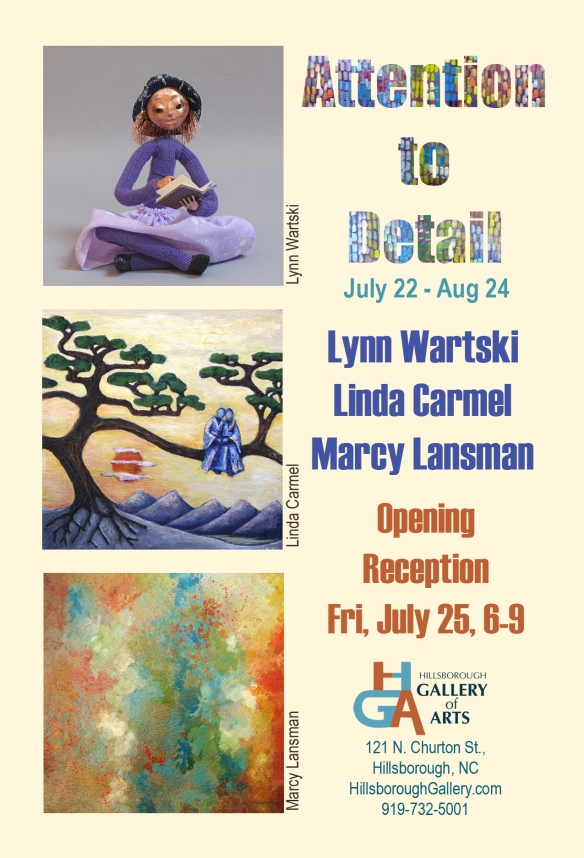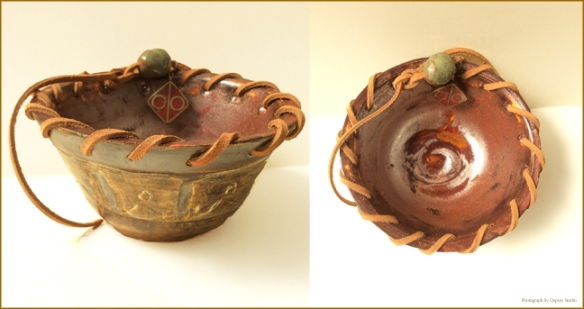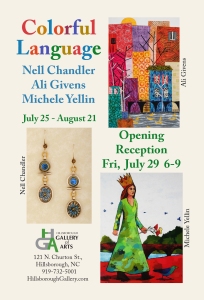
There is a saying that artists know only too well, “the devil is in the details.” The smallest detail can sometimes totally transform a work of art. Although the approaches of artists Linda Carmel, Marcy Lansman and Lynn Wartski are very different, for each of them details are crucial.
Marcy Lansman, whose previous work included very detailed representational paintings, decided to go in a different direction. “Most of the pieces in this show are non-representational. The unifying element is their color palette, which ranges from orange/rust/brown on the one hand through neutral warm gray to blue/blue-green/green on the other. My process has been to lay down a “first draft” quickly in one sitting, restraining myself from any fussing or revising. Inevitably, at the end of this session I feel that I have created a masterpiece! I let this draft sit for a day or so. When I go back, I discover that my masterpiece is not as flawlessly marvelous as it first seemed. Then I begin the process of revising. The challenge then is to clean up the problems without sacrificing the freshness of the original. This is where ‘attention to detail’ comes in.”
Says Lansman, “I have been surprised to discover that I spend just as much time adjusting the details of non-representational as representational work. What is different is the timing and the goal. When I create a drawing, whether it is a flower or a face, I concern myself with details right from the start. In my more abstract work, I focus on major compositional issues at the beginning and deal with the details later. In the representational work, the goal of the details is to capture the appearance and the spirit of the thing I’m painting. In the non–representational work the goal is to create a piece that will be satisfying both to me and to the viewer, something that will please or stimulate or in some way enlighten.”
Lynn Wartski describes the use of detail in her figure sculptures: “For the past couple of years I have concentrated my efforts on small, mixed media figure sculptures that are referred to as ‘sculptural art dolls.’ The intimate scale of these pieces invites the viewer to take a closer look. By their very nature these sculptures require that I pay “attention to detail.”
“Some dolls start as sketches in a book and others are conceived entirely in the studio, but all begin construction with a bit of metalsmithing. Each doll’s face begins as a flat disk cut from copper stock that I anneal, hammer, cut and shape into a face. Eyes are created by torch firing glass enamels on copper or brass nails and tacks. I form the rest of my basic figure from a wooden sphere head atop a twisted wire skeleton. It is at this point that details start to emerge. What will the figure be doing? How will he or she be dressed? Will this be a doll that can live outside? The answers to these and other questions lead to the details that emerge for each figure. One may be simply dressed and seated with a book, another dressed in an ornate costume complete with jewels, and a third riding a bike made just for her.” Wartski enjoys the reactions they and their details draw from viewers. “These figures bring together so much that I have developed in my work over the years.”
Either women or idioms – or sometimes both – are common threads in much of Linda Carmel’s work. However, this year she has brought more global influences into the mix. “I have looked at style and design details from around the world and have used them in each of the paintings in this series,” says Carmel. “Women, cultural designs and idioms are the puzzle pieces I began with in each painting. Even though I started each one with a set of details in mind, it is the “attention to the detail” of the actual painting as it progresses that becomes central. My work is in finding a balance of color and form using those ‘puzzle pieces’ I began with.”
Carmel works with acrylic modeling paste to form three-dimensional paintings on canvas. “I want viewers to become intimate with the painting by feeling the contours of the surface” she says.
Opening Reception
July 25
6-9
Please visit our website
To receive Hillsborough Gallery of Arts Newsletter please complete the form below with your name and email address.




